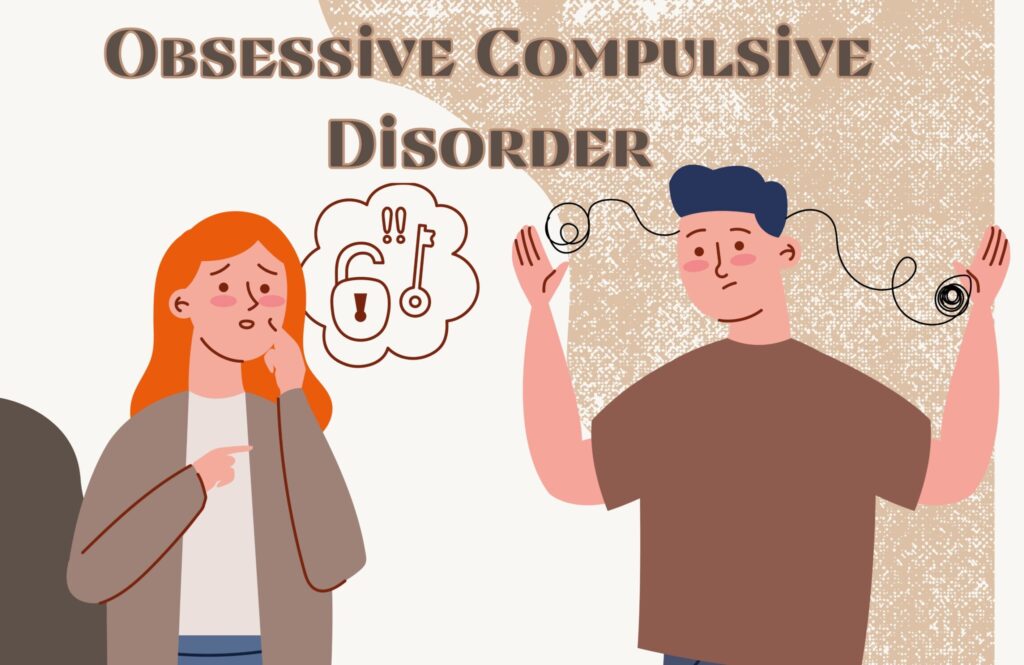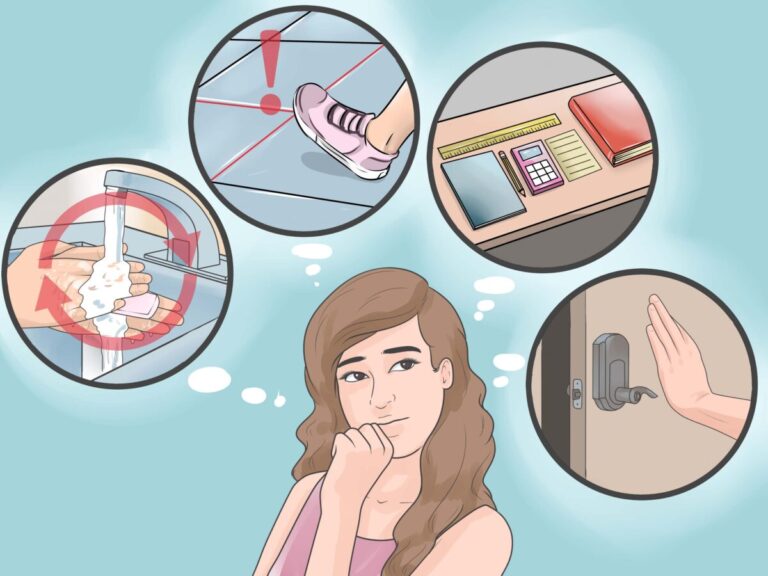Obsessive-Compulsive Disorder (OCD) is a mental health condition that falls under the umbrella of anxiety disorders. Affecting 2-3% of the population, OCD can cause significant distress, disrupt daily life, and interfere with personal relationships. People with OCD experience obsessions persistent, unwanted thoughts, images, or impulses and compulsions ritualistic behaviors or mental acts performed to reduce anxiety.
Despite knowing that their obsessions and compulsions are excessive or irrational, individuals with OCD often feel powerless to control them. This article delves into the symptoms, causes, and treatments of OCD and provides practical tips for managing the disorder.

Understanding OCD
OCD usually begins in late childhood or early adolescence, though it can develop at any age. The disorder involves a cycle of obsessive thoughts and compulsive behaviors. Obsessions are often extreme versions of common fears or concerns, while compulsions are repetitive actions performed to neutralize the distress caused by obsessions.
For many, OCD becomes a source of shame and embarrassment, leading them to hide their symptoms. Left untreated, OCD can have profound effects on an individual’s quality of life, relationships, and ability to function at work or school.
Table: Common Obsessions and Compulsions in OCD
| Category | Common Obsessions | Common Compulsions |
|---|---|---|
| Contamination | Fear of germs, dirt, or toxins. | Excessive handwashing, cleaning, or disinfecting objects and surfaces. |
| Harm | Fear of harming oneself or others, either accidentally or intentionally. | Checking locks, appliances, or repeatedly seeking reassurance from others. |
| Symmetry and Order | Intense need for things to be symmetrical, aligned, or in a specific order. | Arranging objects in precise ways, repeatedly counting or tapping items. |
| Forbidden Thoughts | Intrusive, unwanted thoughts about violence, sex, or blasphemy. | Mentally replacing “bad thoughts” with “good thoughts” or performing rituals. |
| Doubt and Responsibility | Fear of making mistakes or being responsible for bad outcomes. | Excessive checking, such as rereading documents or retracing steps. |
Symptoms of OCD
OCD symptoms fall into two main categories: obsessions and compulsions. These symptoms vary in intensity and can change over time.
Obsessions
Obsessions are intrusive thoughts, images, or impulses that cause significant anxiety or distress. Common obsessions include:
- Fear of contamination from germs, dirt, or harmful substances.
- Fear of harm coming to oneself or loved ones, often coupled with an exaggerated sense of responsibility to prevent it.
- Intrusive and distressing thoughts about violence, accidents, or taboo topics.
- A preoccupation with symmetry, exactness, or orderliness.
- Excessive concerns about morality, religious issues, or health.
Obsessions are often triggered by specific objects, situations, or events but can also arise spontaneously. These thoughts do not respond to logic, and the resulting anxiety often leads to compulsive behaviors aimed at alleviating distress.
Compulsions
Compulsions are repetitive behaviors or mental acts performed to reduce the anxiety caused by obsessions. Common compulsions include:
- Excessive handwashing, showering, or cleaning.
- Checking behaviors, such as repeatedly verifying that doors are locked or appliances are off.
- Arranging items in a specific order or symmetry.
- Counting, tapping, or repeating certain actions a specific number of times.
- Mentally repeating words, phrases, or numbers.
- Seeking reassurance or confessing perceived wrongdoings.
These behaviors provide temporary relief from anxiety but ultimately reinforce obsessive thoughts, creating a vicious cycle.
The Impact of OCD
OCD can have far-reaching effects on a person’s life. Obsessions and compulsions can consume hours each day, interfering with daily activities, work, and relationships. Many individuals with OCD experience additional challenges, including:
- Avoidance behaviors: Avoiding objects, situations, or places that might trigger obsessions.
- Co-occurring conditions: Depression, social anxiety, and panic disorder often accompany OCD.
- Isolation: The shame and embarrassment associated with OCD symptoms can lead to social withdrawal.
In severe cases, OCD can leave individuals housebound or unable to perform basic tasks, such as eating, shopping, or working. Family dynamics can also be affected, as loved ones may inadvertently become involved in the individual’s rituals or experience frustration and distress.
Causes of OCD
The exact cause of OCD remains unknown, but several factors are believed to contribute to its development.
- Learned Behaviors: Compulsions may begin as learned responses to reduce anxiety and become habitual over time.
- Genetics: A family history of OCD or related conditions may increase the likelihood of developing the disorder.
- Brain Chemistry and Structure: Abnormalities in the serotonin system and certain brain regions have been linked to OCD.
- Personality Traits: Perfectionism, a need for control, or difficulty coping with uncertainty may predispose individuals to OCD.
- Stress and Life Events: Traumatic experiences, hormonal changes, or significant life stressors can trigger the onset of OCD or exacerbate symptoms.
Treatment for OCD
Effective treatments are available for OCD, and early intervention can significantly improve outcomes. Treatment typically involves a combination of psychotherapy, medication, and self-help strategies.
Cognitive Behavioral Therapy (CBT)
CBT is the most effective psychological treatment for OCD. It focuses on identifying and changing thought patterns and behaviors that perpetuate the disorder. A specific technique called Exposure and Response Prevention (ERP) is often used in CBT. ERP involves gradually exposing the individual to situations that trigger obsessions while helping them resist the urge to perform compulsions. Over time, this process reduces anxiety and builds resilience.
Medication
Certain medications, particularly selective serotonin reuptake inhibitors (SSRIs), have been shown to reduce OCD symptoms by regulating serotonin levels in the brain. Antidepressants are commonly prescribed and can be effective when combined with therapy.
Anxiety Management Techniques
Practicing relaxation techniques, mindfulness meditation, and slow breathing exercises can help reduce overall anxiety levels, making it easier to manage OCD symptoms. These techniques are most effective when used alongside a structured treatment plan.
Support Groups and Education
Joining a support group can provide a sense of community and understanding. Sharing experiences with others facing similar challenges can reduce feelings of isolation and offer practical advice for managing symptoms.
Hospitalization
For individuals with severe OCD, short-term hospitalization may be necessary to stabilize symptoms and provide intensive treatment.
Self-Help Tips for Managing OCD
In addition to professional treatment, individuals with OCD can take steps to manage their symptoms and improve their quality of life.
Refocus Your Attention
Engage in activities that redirect your focus, such as exercising, playing games, or practicing a hobby.
Challenge Obsessive Thoughts
Write down your obsessive thoughts to recognize their repetitive nature and reduce their power.
Anticipate Urges
Prepare yourself for situations that might trigger compulsions and practice delaying or resisting the behavior.
Set Aside Worry Time
Designate a specific time each day to address obsessive thoughts. When they arise outside this period, remind yourself to save them for later.
Practice Relaxation
Incorporate mindfulness, meditation, or deep breathing exercises into your daily routine to reduce overall stress levels.
Seek Support
Open up to trusted friends or family members about your challenges. Their understanding and encouragement can make a significant difference.
Tips for Supporting Someone with OCD
If you know someone living with OCD, your support can play a crucial role in their recovery.
- Learn about OCD to better understand their experiences.
- Avoid enabling their compulsions or participating in rituals.
- Be patient and compassionate, even when their behavior seems irrational.
- Encourage them to seek professional help and offer to accompany them to appointments if needed.
- Celebrate their progress, no matter how small, to build confidence and motivation.
Authentic US Sources for Further Information
National Institute of Mental Health (NIMH): www.nimh.nih.gov
International OCD Foundation (IOCDF): www.iocdf.org
Anxiety and Depression Association of America (ADAA): www.adaa.org
Mayo Clinic: www.mayoclinic.org
Substance Abuse and Mental Health Services Administration (SAMHSA): www.samhsa.gov
Conclusion
Obsessive-Compulsive Disorder is a complex and often misunderstood condition, but effective treatments are available. Understanding its symptoms, causes, and treatment options can empower individuals and their loved ones to seek help and build strategies for managing the disorder.
With the right combination of therapy, medication, and self-help techniques, people with OCD can regain control over their lives and significantly reduce the impact of their symptoms. If you or someone you know is struggling with OCD, don’t hesitate to reach out for professional support. Help is available, and recovery is possible.


